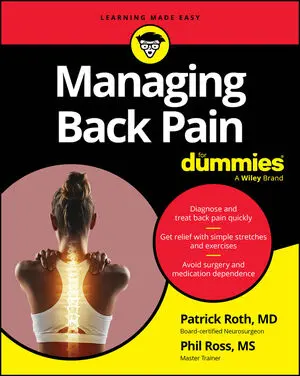Articles & Books From Aches & Pains
Discover countless options for rest and relief when you have chronic back pain You're probably not thrilled that you need a book called Managing Back Pain For Dummies, but you'll be thrilled that you bought it. Written by a neurosurgeon and a master personal trainer, this book contains expert advice that will help you feel better.
Cheat Sheet / Updated 09-22-2025
Your back hurts, and you want to know what to do about it. Congratulations! You’ve come to the right place. We may not be able to tell you what’s causing your pain (probably nobody can), but we can tell you how to build a stronger back, and that’s likely to make the pain go away or reduce it to a point at which you can start enjoying your life again.
Cheat Sheet / Updated 03-27-2016
Back pain is such a common condition that many doctors consider it a normal part of life — but you don't have to suffer. To start, know when to see a doctor for your pain, learn how to choose the right doctor to treat it, and ask smart questions about the tests and treatments your doctor suggests. Managing back pain requires home care, too; so develop a plan for managing your back pain at home.
Article / Updated 03-26-2016
Nearly 80 percent of people suffer lower-back pain at some point in their adult lives. You may have a nagging stiffness that makes tying your shoes a difficult proposition, or you may have a chronic, debilitating pain that keeps you curled up in bed for weeks at a time. Although regular workouts (especially abdominal and back exercises) can do a lot to help prevent back pain, fitness activities can also cause back problems, particularly if you do a lot of pounding or use improper form when you run or cycle.
Article / Updated 03-26-2016
Almost everyone has heard the phrase, "No pain, no gain." What most people don't know is the definition of pain. Pain is the body's warning sign that it's in jeopardy of being injured. A more appropriate phase would be, "If it hurts, don't do it." You may be performing an exercise incorrectly, or the exercise may not work well for you.
Article / Updated 03-26-2016
Knee function is controlled by more muscles, tendons, ligaments, and cartilage than any other joint in your body. That’s one reason why it’s often the first joint to break down and cause pain. The other is that the knees are involved in virtually every sport or activity, making it the most common joint to suffer injury.
Article / Updated 03-26-2016
The rotator cuff is a group of four muscles that surround and protect your shoulder joint. They’re particularly delicate and susceptible to injury. If you can’t raise your arm, you may have a rotator-cuff tear. The rotator cuff can tear if your arm is violently pulled or twisted or if you fall with your arm outstretched.
Article / Updated 03-26-2016
Stress fractures are typically not one but a series of micro-fractures or hairline breaks that run along the bone. Long-distance runners, hikers, backpackers, and in-line skaters are the most common sufferers of stress fractures. With a stress fracture, you typically don’t have a telltale snap or pop that occurs in other breaks.
Article / Updated 03-26-2016
Internal and external rotation exercises, grouped together, help you strengthen the rotator cuff area deep in your shoulder. If you're starting an exercise routine, it's natural to want to target your waist or thighs, but it's better not to overlook exercises that strengthen an injury-prone area like the rotator cuff.
Article / Updated 03-26-2016
That tingling and numbness radiating from your wrist to your palm and fingers was probably no big deal at first. After all, you could literally shake it off by shaking your hand. But lately, you’ve noticed that uncomfortable feeling has become painful and you’re losing your grip strength. The bad news: You might have carpal tunnel syndrome (CTS).



